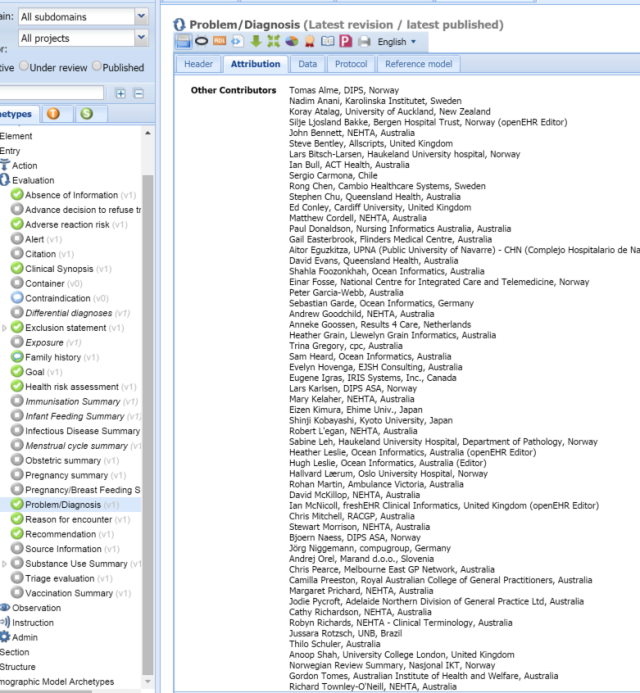(on their own)
Every so often I remember how we were taught to build information systems and software. One of the steps is called ‘requirements capture’. The IT people are supposed to go and interrogate domain experts, in a step called ‘use case modelling’, obtaining those diamonds of information that will allow them to build the system those experts want.
There’s only one problem with that. In all real domains, the IT people and domain experts have no clue what each 0ther is saying. And yet the IT people still go and build a system. Any system. And that’s why most information systems are a) semantically broken and b) can’t keep up to date with new requirements.
We have known this doesn’t work for 20 years in health (some savvy people knew it for a lot longer). In health, just like any other real domain, you can’t afford to put any of the following in the software:
- domain content / information models
- workflows
- terminology
- ontology
- higher-level artefacts such as guidelines (health), business rules etc.
The solution is to find ways of enabling domain experts themselves to build models and descriptions of their domain. Our contribution in openEHR was to provide a way of doing the first, the so-called ‘archetypes’.
To see just how unlikely it is that IT people could build a model of health domain content, such as the information used to record ‘problems’ and ‘diagnoses’, have a look at the contributors list of the problem/diagnosis archetype in the openEHR CKM:
Here’s the list of contributors, in a more digestible form (total = 59):
Norway (10)
- Nasjonal IKT: Norwegian Review Summary
- DIPS: Tomas Alme, Bjoern Naess, Lars Karlsen
- Bergen Hospital Trust: *Silje Ljosland Bakke
- Helse Bergen: John Tore Valand
- Haukeland University hospital: Lars Bitsch-Larsen, Sabine Leh
- National Centre for Integrated Care and Telemedicine: Einar Fosse
- Oslo University Hospital: Hallvard Lærum
New Zealand (1)
- University of Auckland: Koray Atalag
Australia (33)
- Royal Australian College of General Practitioners: Chris Mitchell, Camilla Preeston, Kylie Young
- NEHTA: David McKillop, Stewart Morrison, Margaret Prichard, Cathy Richardson, Robyn Richards, Richard Townley-O’Neill, John Bennett, Matthew Cordell, Mary Kelaher, Robert L’egan, Andrew Goodchild
- Queensland Health: Stephen Chu, David Evans
- Nursing Informatics Australia: Paul Donaldson
- Flinders Medical Centre: Gail Easterbrook
- Ocean Informatics: *Heather Leslie, Sam Heard, Hugh Leslie, Shahla Foozonkhah
- ACT Health: Ian Bull
- (individuals): Peter Garcia-Webb, Thilo Schuler, Gordon Tomes,
- Ambulance Victoria: Rohan Martin
- Melbourne East GP Network: Chris Pearce
- Adelaide Northern Division of General Practice Ltd: Jodie Pycroft
- ACCTI-UoW: Donna Truran
- Llewelyn Grain Informatics: Heather Grain
- cpc: Trina Gregory
- EJSH Consulting: Evelyn Hovenga
Sweden (2)
- Karolinska Institutet: Nadim Anani
- Cambio Healthcare Systems: Rong Chen
United Kingdom (4)
- Allscripts: Steve Bentley
- Cardiff University: Ed Conley
- freshEHR Clinical Informatics: *Ian McNicoll
- University College London: Anoop Shah
Brazil (1)
- National University of Brasilia: Jussara Rotzsch
Chile (1)
- (individuals): Sergio Carmona
Spain (1)
- UPNA (Public University of Navarre) – CHN (Complejo Hospitalario de Navarra): Aitor Eguzkitza
Germany (2)
- Compugroup: Jörg Niggemann
- Ocean Informatics: Sebastian Garde
Netherlands (1)
- Results 4 Care: Anneke Goossen
Canada (1)
- IRIS Systems, Inc.: Eugene Igras
Japan (1)
- Ehime Univ.: Eizen Kimura
- Kyoto University: Shinji Kobayashi
Slovenia (1)
- Marand d.o.o.: Andrej Orel
So let’s just try to imagine by what means the IT experts trying to build a system or component that knows (properly) about recording Diagnoses and Problems could get access to the expert input of 59 people from 13 countries, many of them exceedingly busy senior clinical professionals?
Answer: there isn’t one. Developers on their own have no way to achieve this. They don’t even know who to ask. Now, multiply this problem by the other 400+ archetypes in the CKM, and remember that CKM has 1,500 or so registered clinical reviewers. And let’s assume that the ultimate number of models needed to cover medicine is more like 2,000.
It’s clear that there is no hope whatever of software developers figuring this out. Some health informatics types might imagine that the developers could go to some standards meetings (ISO, HL7, ASTM etc). But the clinical people won’t be there; most of them don’t know the first thing about health informatics standards.
The only way to achieve semantic modelling of the health domain is for domain models to be built as a completely independent activity, separated from specific software products, solutions, or technologies, run by and for domain experts.
Semantically rich system development is only possible in the health domain in this ‘inside-out’ way. Clearly, making it happen for real requires significant vision, planning and resources.
The question is: do today’s health IT programmes and funding frameworks have it?



Good points, well made.
@OperonHealthSys
I love it – especially as I’m mentioned by name 🙂 !
Pingback: Would you like to build health and care software 100 times faster? | Woodcote Consulting
Pingback: Ewan Davis: the content challenge – Digital Health Intelligence